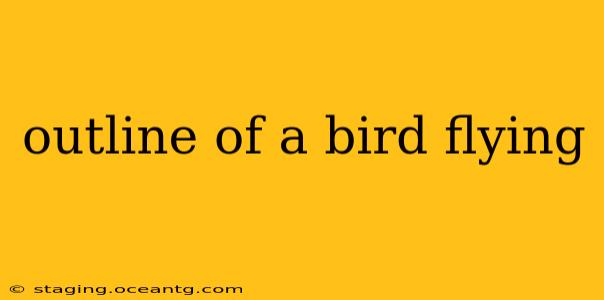The Anatomy of a Bird in Flight: An Outline
This outline explores the various aspects of a bird's flight, from the physical adaptations that make it possible to the aerodynamic principles involved. It's designed to be comprehensive and informative, suitable for a blog post or a longer-form article.
I. Introduction: The wonder of avian flight – a captivating natural phenomenon. Briefly introduce the topic and its significance.
II. Physical Adaptations for Flight:
- A. Skeletal Structure: Lightweight yet strong bones (pneumatic bones), fused bones for stability (e.g., furcula – wishbone), reduced number of bones. Discuss the role of each adaptation in flight.
- B. Muscular System: Powerful pectoral muscles (flight muscles), their attachment to the keel of the sternum, and their role in generating lift and thrust. Include discussion of other important flight muscles.
- C. Feathers: Structure and function of different types of feathers (flight feathers, down feathers, coverts). Explain how feathers create lift and streamline the bird's body.
- D. Respiratory System: Efficient respiratory system with air sacs, enabling continuous oxygen supply to flight muscles. Explain how this system differs from mammalian respiration.
- E. Cardiovascular System: Efficient heart and circulatory system to deliver oxygen and nutrients to muscles. Discuss adaptations for efficient oxygen transport.
III. Aerodynamics of Flight:
- A. Lift: Explain Bernoulli's principle and how the shape of the wings (airfoil) generates lift. Discuss the role of angle of attack.
- B. Thrust: How birds generate thrust using their wings, focusing on the downstroke and upstroke. Discuss the role of tail feathers in steering.
- C. Drag: Explain drag and how birds minimize it through streamlined body shape and feather arrangement.
- D. Gravity: The force working against flight, and how birds overcome it through lift generation.
IV. Types of Flight:
- A. Flapping Flight: The most common type, detailing the mechanics of wingbeats and their variations (e.g., rapid flapping of hummingbirds, slow flapping of eagles).
- B. Gliding Flight: Efficient flight using air currents and minimizing energy expenditure. Discuss soaring and gliding techniques.
- C. Hovering Flight: Explain how hummingbirds and some other birds maintain stationary flight.
V. Variations in Flight Among Bird Species:
- Discuss adaptations in different bird species for different flight styles and environments (e.g., long-distance migration, high-altitude flight, maneuvering in forests).
VI. Conclusion: Summarize the key points about the complexity and elegance of avian flight, highlighting the remarkable interplay of physical adaptations and aerodynamic principles.
VII. (Optional) Frequently Asked Questions (PAAs): This section can incorporate questions like:
- How do birds learn to fly?
- What is the fastest bird in the world?
- How do birds migrate over such long distances?
- Do all birds fly? (Discuss flightless birds)
- How do birds navigate during migration?
This outline provides a structured approach to creating a comprehensive and engaging piece about the fascinating subject of bird flight. Remember to use vivid language and incorporate relevant imagery to enhance the reader's understanding and appreciation of this natural marvel.
